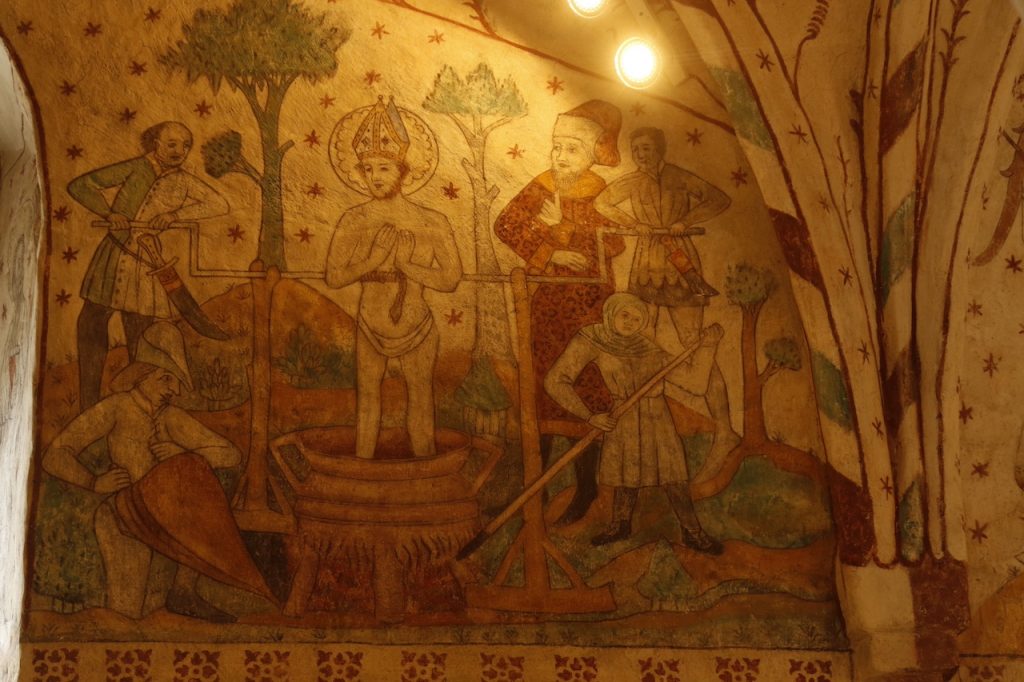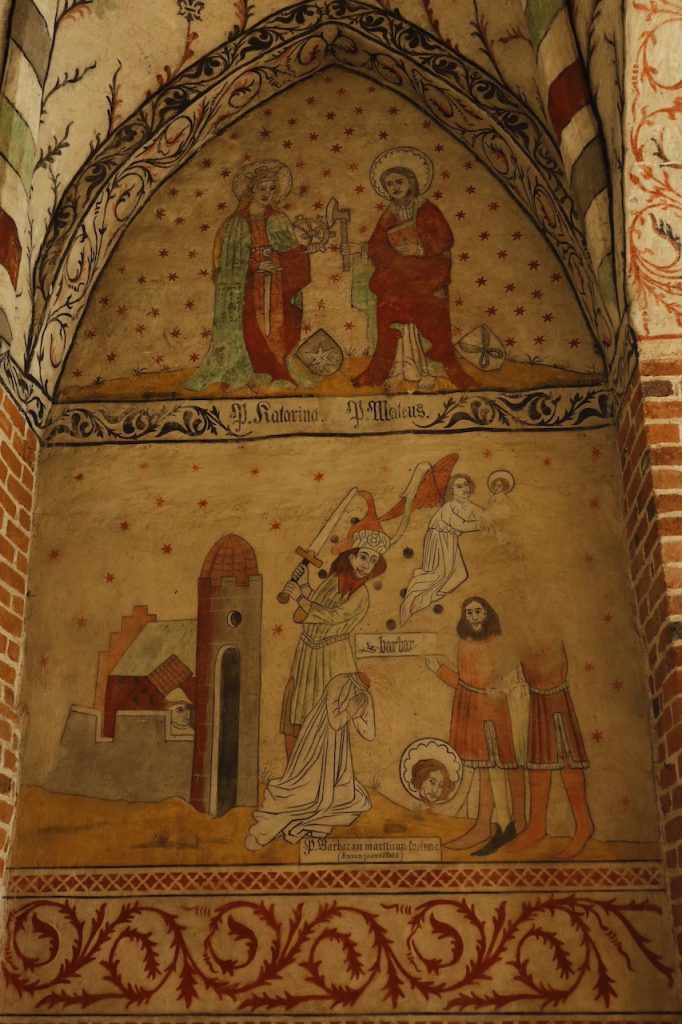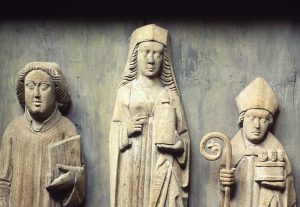Wall-paintings in Finnish Churches in the ‘Mapping Saints’ Database, part 1
Postat den 13th April, 2023, 14:27 av Sara Ellis Nilsson
Vilma Mättö, Linnaeus University and University of Turku
Medieval church paintings combine a wide range of material that can broaden our perception of how different saints were venerated – which saints were chosen to be immortalized on the church walls and how their legends were visually retold. In the former medieval diocese of Turku situated in present-day Finland, the pictorial compositions featuring saints exist in approximately 30 medieval churches. Throughout 2022, the Mapping Saints database was supplemented with saints’ cult manifestations that occur within this material. In this first blog-post, I will outline some major characteristics that the Finnish medieval church paintings have and continue in the next post by mentioning a couple of examples that demonstrate how these special features should be considered especially when studying the images of saints.
Out of over 80 preserved stone churches in Finland there are around 47 in total that have murals from the medieval period. Extant paintings range from single fragments or consecration crosses to extensive and detailed schemes recounting episodes from the Bible and other religious texts. The Finnish medieval paintings can roughly be divided into two main categories: the paintings made by painting workshops or individual painters who apparently have had some level of professional education, and the paintings that are plainer in their execution and have presumably been created by the construction workers of the church (Fält 2012, 11). The oldest wall painting series located in Finland are found in the churches of Jomala and Lemland, Åland, both dated to around 1300 (Hiekkanen 2020, 48–49). The majority of the Finnish medieval church painting series were executed in the latter part of the 15th century and in the early 16th century though and are situated mostly in Southwest Finland and Uusimaa.
Three major groups of professional workshops can be identified within the best-preserved painting compositions. The earliest works of these are attributed to the so-called Taivassalo Group, which was active in Southwest Finland from 1467-1490 and has painting series in, for example, the churches of Taivassalo/Tövsala, Kalanti/Kaland (Fig. 2), Laitila/Letala, and Parainen/Pargas (Aaltonen 1999, 14, 16). Characteristic of the Taivassalo Group’s paintings is the emphases on the Passion history and martyrdom legends, as well as a notable influence from mystery plays and theological literature like Speculum Humanae Salvationis. In addition, series showing the Apostles creed and various depictions of saints with adjoining coats of arms or portrayals of the donors are common in their work.

Figure 1. The martyrdom of St Erasmus in the church of Kalanti. Photo by Janika Aho.
Another group of painting programs that show strong similarity with each other are found in the churches of Inkoo/Ingå, Espoo/Esbo and Siuntio/Sjundeå, all located in Uusimaa. The date of the murals in these churches is estimated to somewhere between the years 1510 and 1520. One distinctive feature of the paintings in the abovementioned churches is that the figures are depicted with their eyes closed, although otherwise the subjects differ among these three compositions. Typological scenes from the Old Testament are noticeable in Espoo and Siuntio, whereas the focus in Inkoo is on the New Testament with the addition of exceptional memento mori themed motifs. (Aho 2020, 37; Riska 1987, 161–167).
The painting series in the churches of Hattula and Lohja/Lojo were most likely produced by the same group of professionals in the 1510s. The church of Hattula is not only famous for its unique brick structure and having the status as a pilgrimage destination in the Middle Ages, but also for its eye-catching painting program that covers almost all surfaces of the interior and having survived time relatively well (Fig. 1). The pictorial compilation is rich with representations of over 50 different saints, including, for example, majestic sequences showing the miracles of the Virgin (Edgren 1993, 66–67). In Lohja church the painting series is also extensive with large-scale depictions of biblical themes and legends.

Figure 2. Murals from the first decade of the 16th century in the church of Hattula. Photo by Janika Aho.
Other painting series worth mentioning are those in the church of Kumlinge in Åland, made by an unknown painter, and in the church of Rymättylä/Rimito in Southwest Finland, attributed to the Swedish master Lars Snickare. Both of these mural series were most probably completed in the 1510s (Hiekkanen 2020, 182, Nilsén 1982, 20–41).
In one way or another, medieval art is always fragmentary. Wall paintings have been subject to many changes throughout the centuries. For instance, they have faced damage caused by the weather, being covered with plaster, white-wash, or new layers of paintings, being re-covered, or disturbed by enlargements of windows and other architectural constructions. The way medieval church paintings were treated after the Reformation has varied among countries. In Finland, the majority of wall paintings were left untouched in the early modern period but were eventually covered over at the turn of the 18th and 19th centuries (Valkeapää 2000, 34–46).
Starting in the 1880s, all paintings were documented and restored. In those churches where paintings had been covered the century previously, they were first revealed under the whitewash, naturally exposing the fragile coat of paint to sunlight and interior heating. The restoration work in most churches followed conventions of the period, which included heavily overpainting and sometimes even changing the location of individual images by using copies of the original ones (Fig. 3). In many churches, it was decided to completely or partially re-whitewash some of the paintings after they had been documented, and it is difficult to estimate how many paintings still remain under plaster (Valkeapää 2015, 105–106; Fält 2012, 12).

Figure 3. Paintings on the east wall in the church of Taivassalo exemplify how heavy-handedly medieval church art was sometimes restored in the 19th century. This wall-painting composition shows representations of St Catherine and St Matthias at the upper section, both restored by densely overpainting, and at the lower part a scene depicting the martyrdom of St Barbara. This scene from St Barbara’s legend is a full copy made after the original painting which was initially located on the south wall but had to be demolished due to new window openings. Photo by Janika Aho.
Another important aspect in analyzing the paintings is that many churches have had more than one pictorial scheme overlaying each other. Even during the Middle Ages one church might have been decorated with two or more temporally separated image series executed by different makers, either by the new layer covering the earlier paintings or by placing the new ones beside the older paintings.
References
Aaltonen, Susanna. “Kalannin ryhmän kuusi maalaria”, SKAS 1 (1999), 14 –21.
Aho, Janika. ”Memento Mori Inkoon Keskiaikaisessa Kirkossa”. Tahiti 10 (2020), 32–55. https://doi.org/10.23995/tht.100180
Edgren, Helena. Mercy and Justice. Miracles of the Virgin Mary in Finnish Medieval Wall-Paintings. Diss. SMYA, FFT 100. Helsinki: SMY, FF, 1993.
Fält, Katja. Wall Paintings, Workshops, and Visual Production in the Medieval Diocese of Turku from 1430 to 1540. Helsinki: Finnish Antiquarian Society, 2012.
Hiekkanen, Markus. Finlands medeltida stenkyrkor, transl. Camilla Ahlström-Taavitsainen. Stockholm: Kungl. Vitterhets historie och antikvitets akademien, 2020.
Nilsén, Anna. “Kalkmålningarna i Rimito kyrka och deras upphovsman”. Finskt Museum (1982), 5–43.
Riska, Tove, “Keskiajan maalaustaide”, in Salme Sarajas-Korte (ed.), Ars: Suomen taide. 1. Espoo: Weilin + Göös, 1987.
Valkeapää, Leena. Pitäjänkirkosta kansallismonumentiksi: Suomen keskiaikaisten kivikirkkojen restaurointi ja sen tausta vuosina 1870-1920. Helsinki: Suomen muinaismuistoyhdistys, 2000.
Valkeapää, Leena. Vapaa kuin lintu: Emil Nervanderin elämä. Taidehistoriallisia tutkimuksia 47. Helsinki: Taidehistorian seura, 2015.
Det här inlägget postades den April 13th, 2023, 14:27 och fylls under wall paintings

